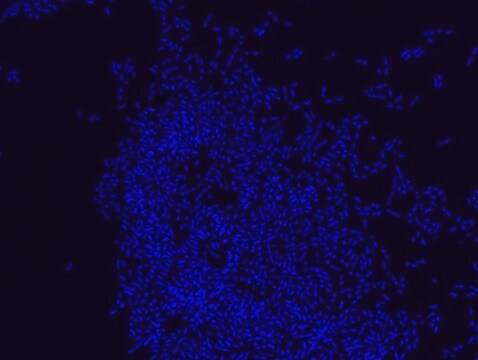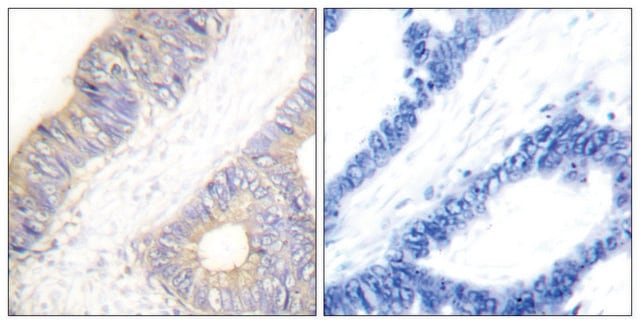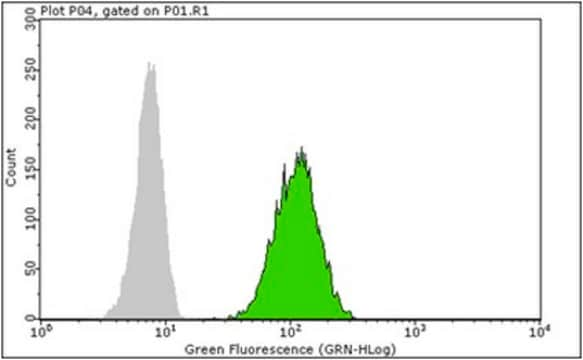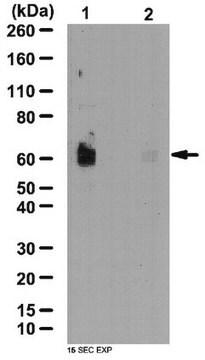MBD0028
Porphyromonas gingivalis FISH probe - ATTO488
Probe for fluorescence in situ hybridization (FISH)
Synonim(y):
POGI
Zaloguj sięWyświetlanie cen organizacyjnych i kontraktowych
About This Item
Kod UNSPSC:
12352200
NACRES:
NA.51
Polecane produkty
Poziom jakości
Postać
liquid
stężenie
20 μM
metody
FISH: suitable
Warunki transportu
dry ice
temp. przechowywania
−20°C
Opis ogólny
Fluorescent In Situ Hybridization technique (FISH) is based on the hybridization of fluorescent labeled oligonucleotide probe to a specific complementary DNA or RNA sequence in whole and intact cells.1 Microbial FISH allows the visualization, identification and isolation of bacteria due to recognition of ribosomal RNA also in unculturable samples.2
FISH technique can serve as a powerful tool in the microbiome research field by allowing the observation of native microbial populations in diverse microbiome environments, such as samples from human origin (blood3 and tissue4), microbial ecology (solid biofilms 5 and aquatic systems6) and plants7. It is strongly recommended to include positive and negative controls in FISH assays to ensure specific binding of the probe of interest and appropriate protocol conditions. We offer positive (MBD0032/33) and negative control (MBD0034/35) probes, that accompany the specific probe of interest.
Porphyromonas gingivalis probe specifically recognizes P. gingivalis cells. P. gingivalis, is a gram negative bacterium which is an etiologic agent of adult periodontitis, a chronic inflammatory disease characterized by the destruction of the supportive tissue surrounding teeth. Studies have shown that LPS from P. gingivalis plays an important role in this disease.8-11 The association of the oral microbiota, including P. gingivalis, with various pathological states has been reported. These include development of Alzheimer′s disease12, role in oral cancers13, preterm birth14 and rheumatoid arthritis15. FISH technique was successfully used to identify P. gingivalis with the probe in various samples such as pure culture (as described in the figure legends), dental implants16,17 , periapical tooth lesions18, saliva19, brain tissue20, gingival and aortic tissues21, biofilms from voice prostheses22, subgingival biofilm23, aortic wall tissue24, and infected HeLa cells25. Moreover, FISH can be implicated to identify P. gingivalis in tumor tissue26, multispecies biofilm27, multispecies oral biofilms28 and pure culture and buccal epithelial cells29.
FISH technique can serve as a powerful tool in the microbiome research field by allowing the observation of native microbial populations in diverse microbiome environments, such as samples from human origin (blood3 and tissue4), microbial ecology (solid biofilms 5 and aquatic systems6) and plants7. It is strongly recommended to include positive and negative controls in FISH assays to ensure specific binding of the probe of interest and appropriate protocol conditions. We offer positive (MBD0032/33) and negative control (MBD0034/35) probes, that accompany the specific probe of interest.
Porphyromonas gingivalis probe specifically recognizes P. gingivalis cells. P. gingivalis, is a gram negative bacterium which is an etiologic agent of adult periodontitis, a chronic inflammatory disease characterized by the destruction of the supportive tissue surrounding teeth. Studies have shown that LPS from P. gingivalis plays an important role in this disease.8-11 The association of the oral microbiota, including P. gingivalis, with various pathological states has been reported. These include development of Alzheimer′s disease12, role in oral cancers13, preterm birth14 and rheumatoid arthritis15. FISH technique was successfully used to identify P. gingivalis with the probe in various samples such as pure culture (as described in the figure legends), dental implants16,17 , periapical tooth lesions18, saliva19, brain tissue20, gingival and aortic tissues21, biofilms from voice prostheses22, subgingival biofilm23, aortic wall tissue24, and infected HeLa cells25. Moreover, FISH can be implicated to identify P. gingivalis in tumor tissue26, multispecies biofilm27, multispecies oral biofilms28 and pure culture and buccal epithelial cells29.
Zastosowanie
Probe for fluorescence in situ hybridization (FISH),recognizes Porphyromonas gingivalis cells
Cechy i korzyści
- Visualize, identify and isolate Porphyromonas gingivalis cells.
- Observe native P. gingivalis cell populations in diverse microbiome environments.
- Specific, sensitive and robust identification of P. gingivalis in bacterial mixed population.
- Specific, sensitive and robust identification even when P. gingivalis is in low abundance in the sample.
- FISH can complete PCR based detection methods by avoiding contaminant bacteria detection.
- Provides information on P. gingivalis morphology and allows to study biofilm architecture.
- Identify P. gingivalis in clinical samples such as, tumor and brain tissues (for example in formalin-fixed paraffin-embedded (FFPE) samples), saliva and oral cavity and medical equipment such as, dental implants and voice prostheses.
- The ability to detect P. gingivalis in its natural habitat is an essential tool for studying host-microbiome interaction.
This page may contain text that has been machine translated.
Kod klasy składowania
12 - Non Combustible Liquids
Klasa zagrożenia wodnego (WGK)
nwg
Temperatura zapłonu (°F)
Not applicable
Temperatura zapłonu (°C)
Not applicable
Certyfikaty analizy (CoA)
Poszukaj Certyfikaty analizy (CoA), wpisując numer partii/serii produktów. Numery serii i partii można znaleźć na etykiecie produktu po słowach „seria” lub „partia”.
Masz już ten produkt?
Dokumenty związane z niedawno zakupionymi produktami zostały zamieszczone w Bibliotece dokumentów.
Érika Gomes Sarmento et al.
Food research international (Ottawa, Ont.), 116, 1282-1288 (2019-02-06)
Probiotics are widely used in the food industry and may affect the oral microbiota. This study aimed to evaluate the effect of petit-suisse plus probiotic on the microbiota of children's saliva. Strawberry flavor petit-suisse cheese plus green banana flour without
Zijian Cheng et al.
Best practice & research. Clinical rheumatology, 31(1), 19-30 (2017-12-10)
There is an epidemiological association between periodontitis and rheumatoid arthritis (RA), which is hypothesised to lead to enhanced generation of RA-related autoantibodies that can be detected years before the onset of RA symptoms. Periodontitis is a common dysbiotic disease; tissue
Chunrong Chang et al.
Applied microbiology and biotechnology, 103(3), 1393-1404 (2018-11-25)
Mounting evidence suggests a causal relationship between specific bacterial infections or microbial compositions and the development of certain malignant neoplasms. In this study, we performed research through 16S rRNA amplicon sequencing, qPCR and fluorescence in situ hybridization to certify the
Irina M Velsko et al.
Infection and immunity, 83(12), 4582-4593 (2015-09-16)
The American Heart Association supports an association between periodontal diseases and atherosclerosis but not a causal association. This study explores the use of the integrin β6(-/-) mouse model to study the causality. We investigated the ability of a polymicrobial consortium
Patricia Romero-Lastra et al.
PloS one, 14(8), e0221234-e0221234 (2019-08-23)
Porphyromonas gingivalis, an oral microorganism residing in the subgingival biofilm, may exert diverse pathogenicity depending on the presence of specific virulence factors, but its gene expression has not been completely established. This investigation aims to compare the transcriptomic profile of
Nasz zespół naukowców ma doświadczenie we wszystkich obszarach badań, w tym w naukach przyrodniczych, materiałoznawstwie, syntezie chemicznej, chromatografii, analityce i wielu innych dziedzinach.
Skontaktuj się z zespołem ds. pomocy technicznej








